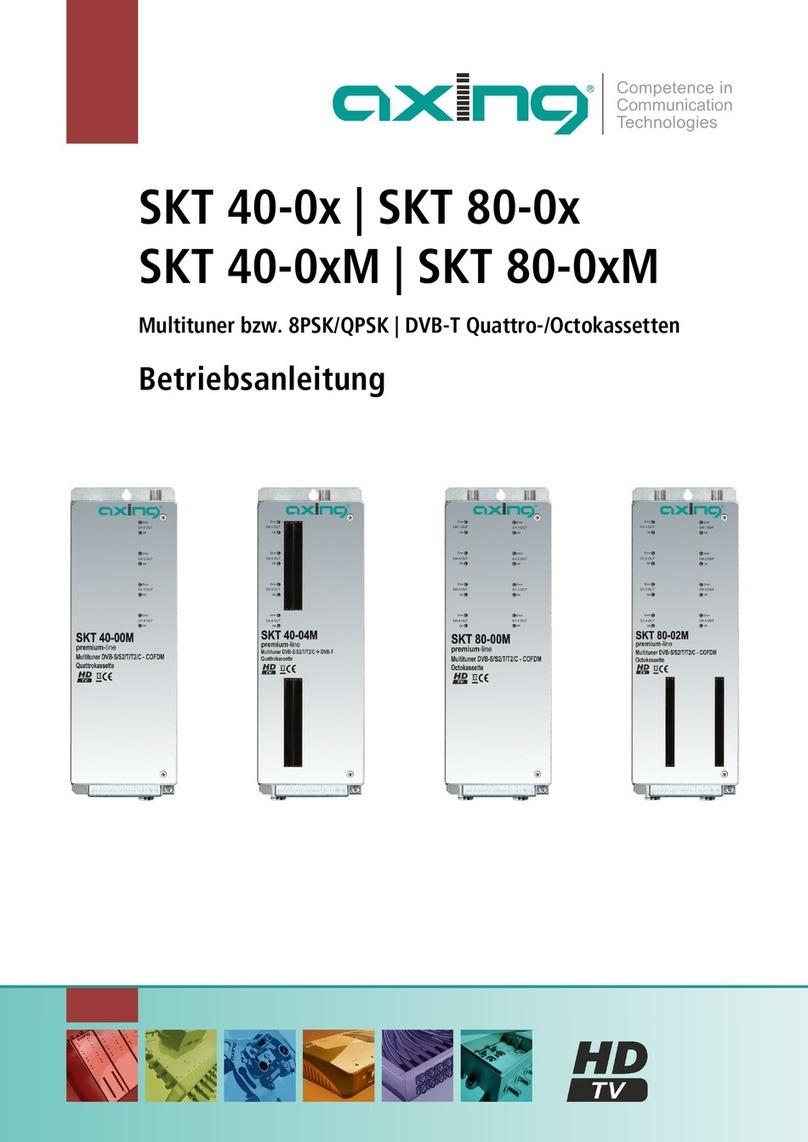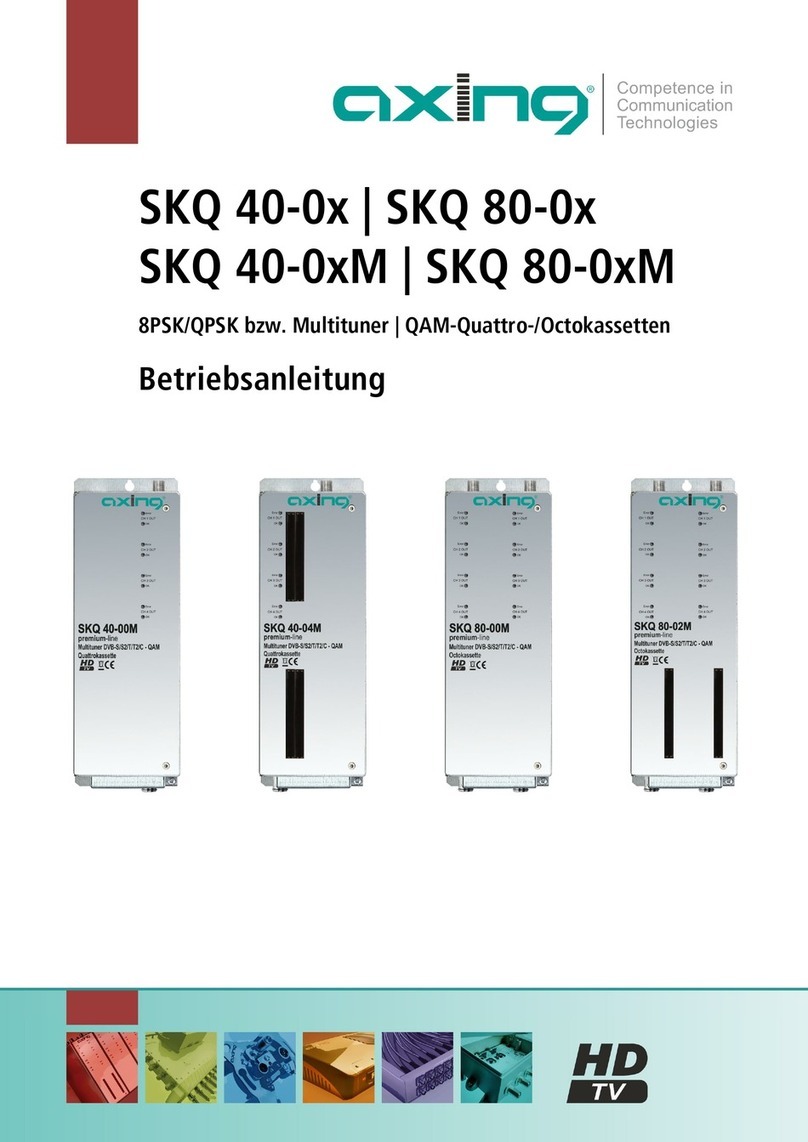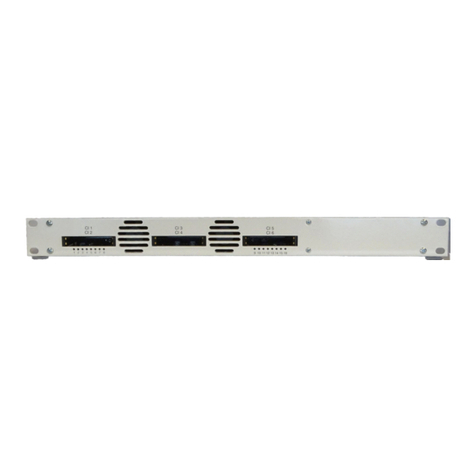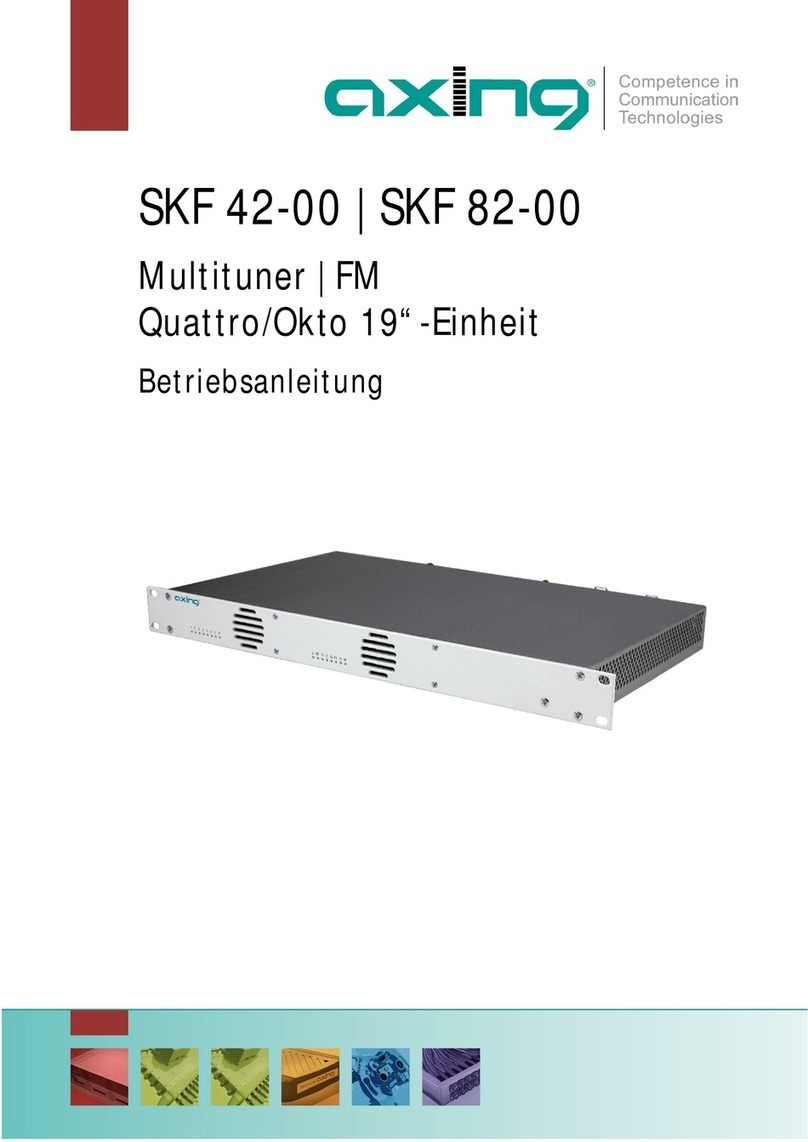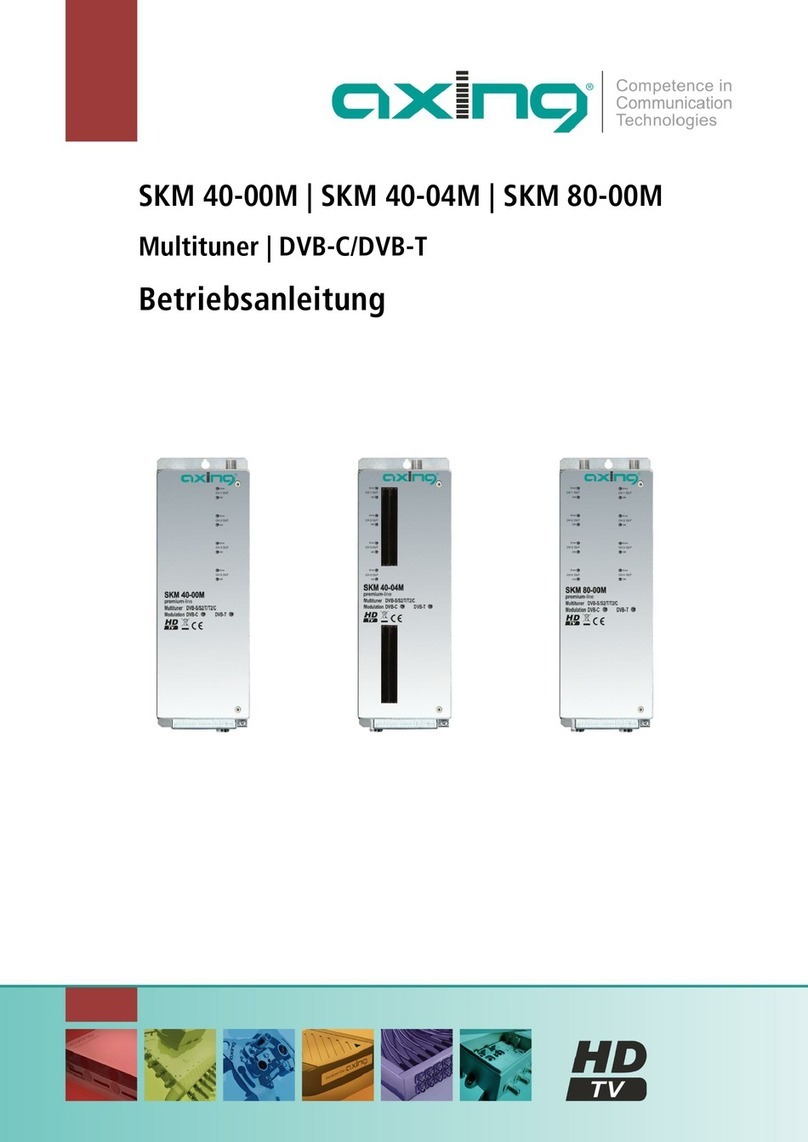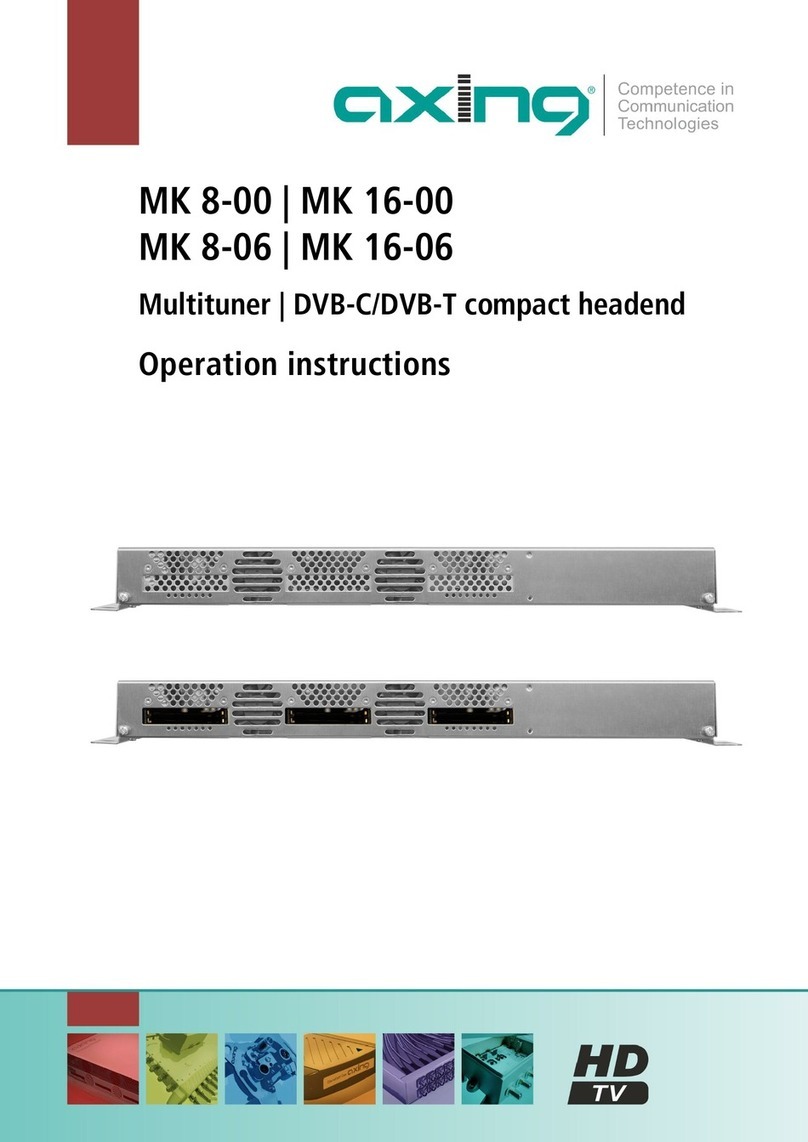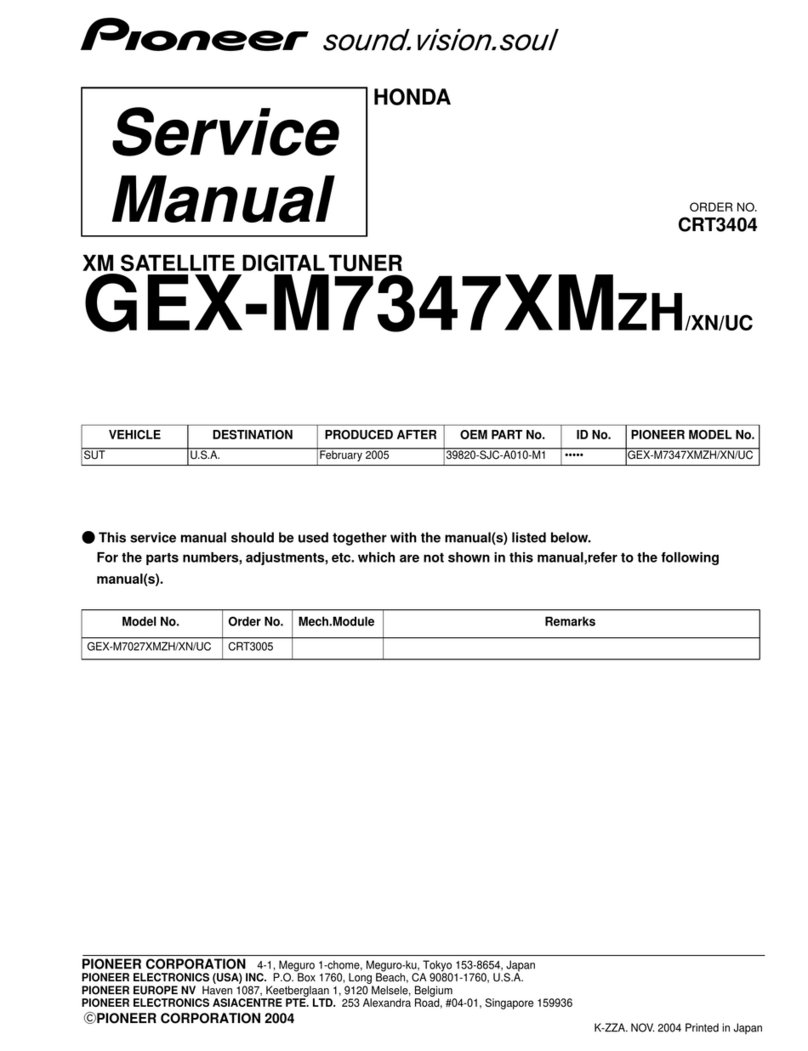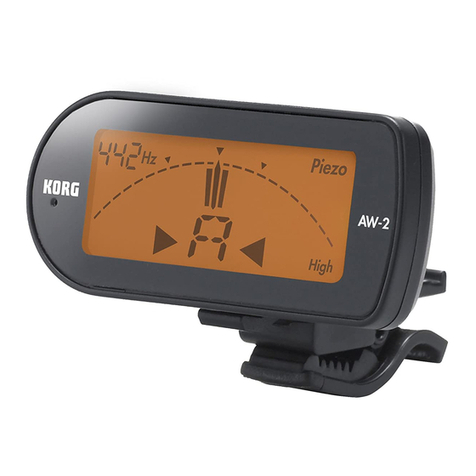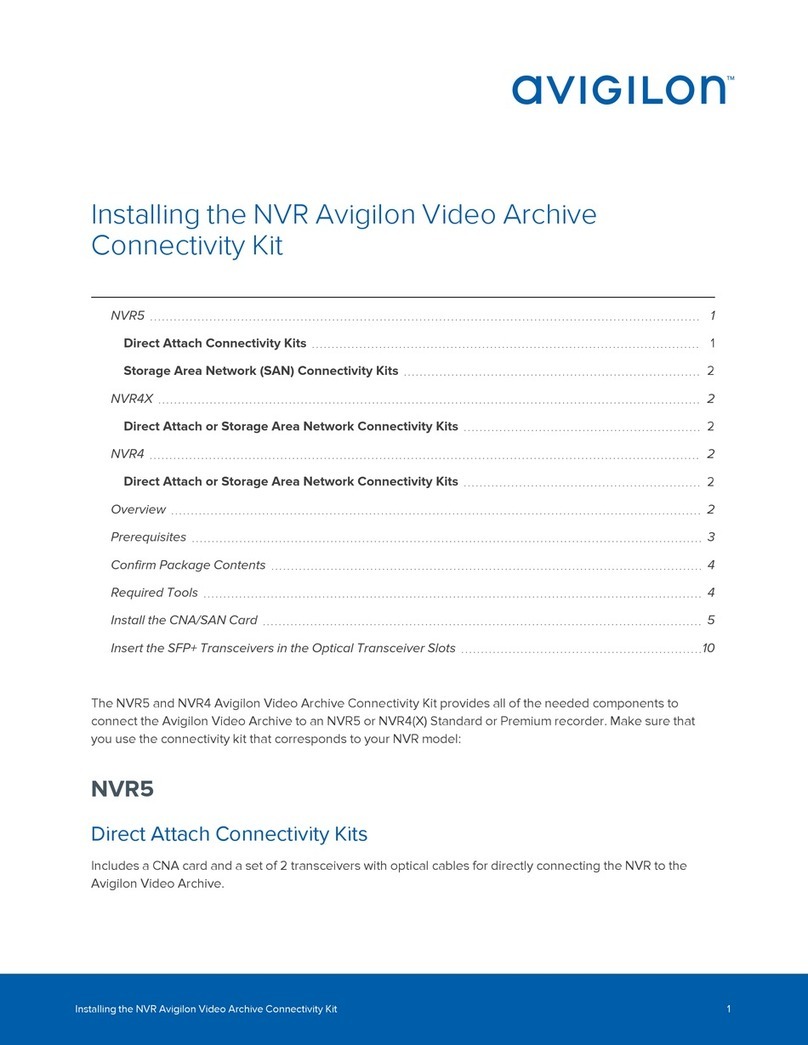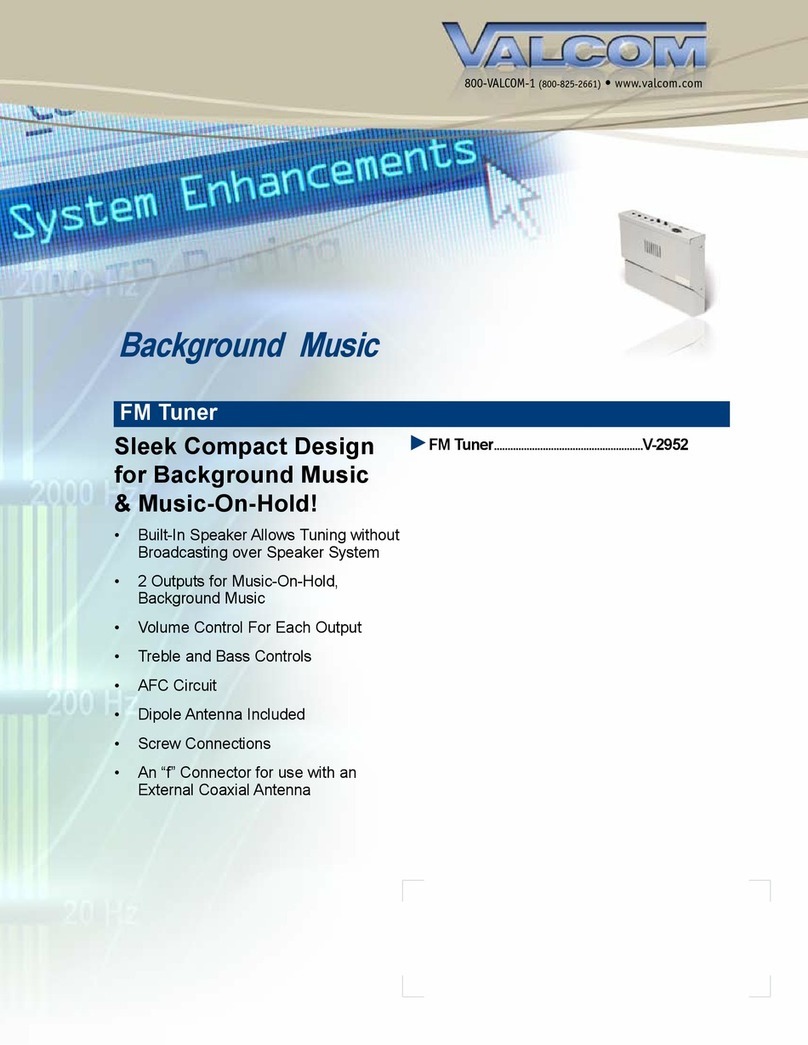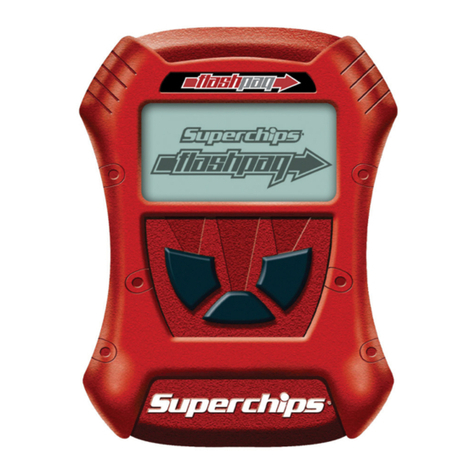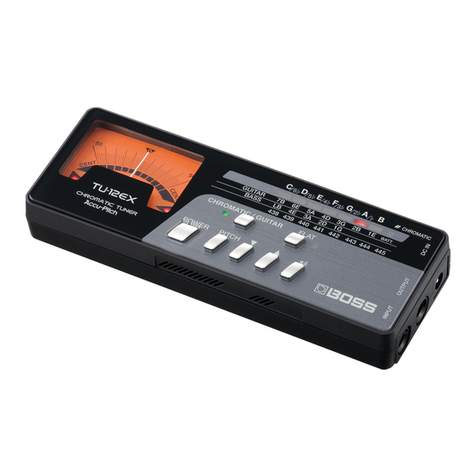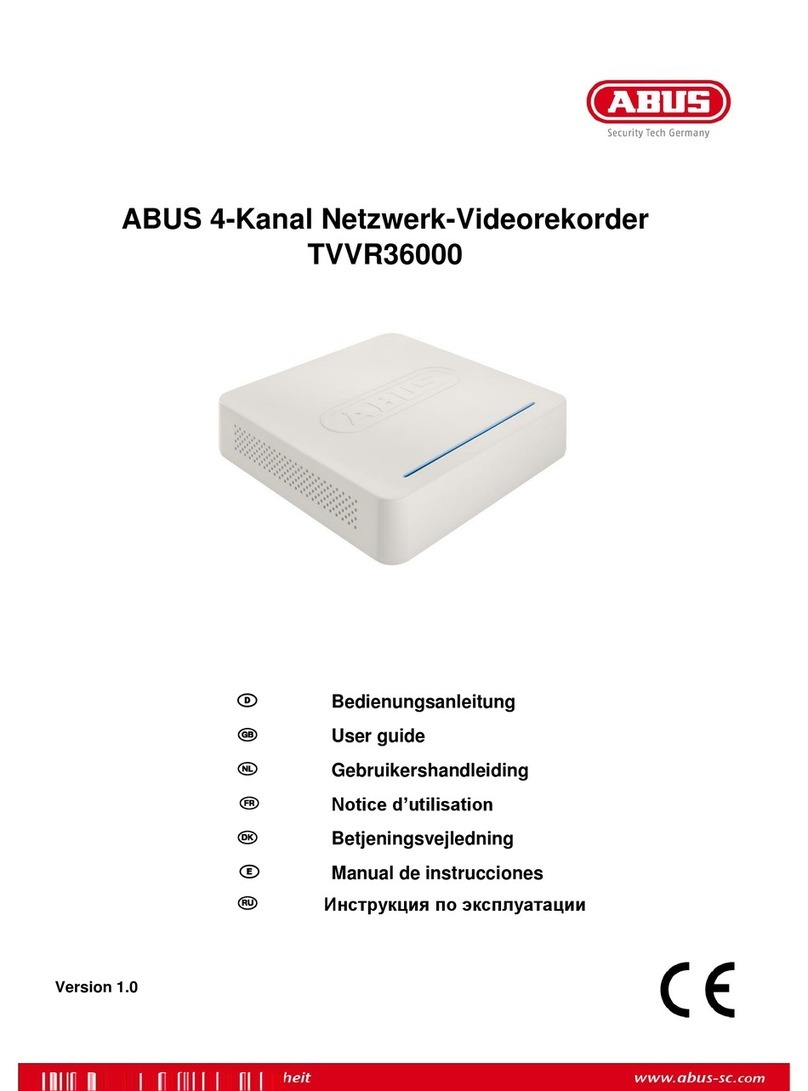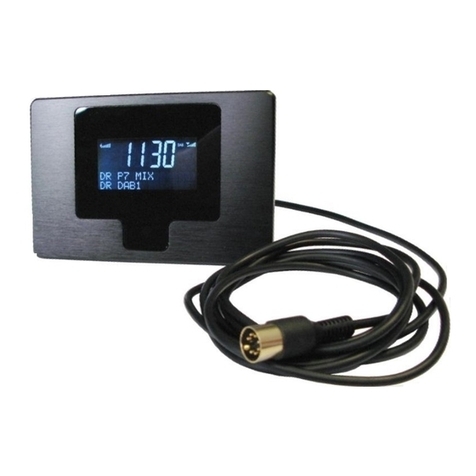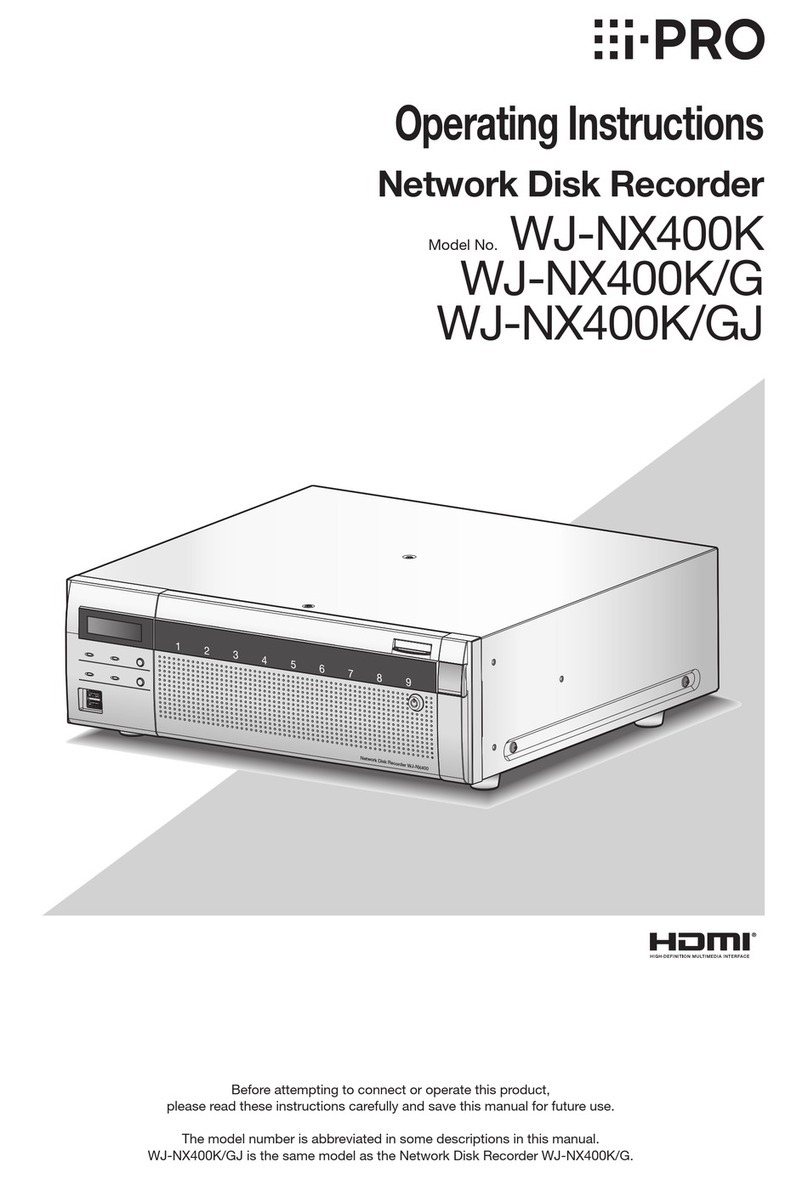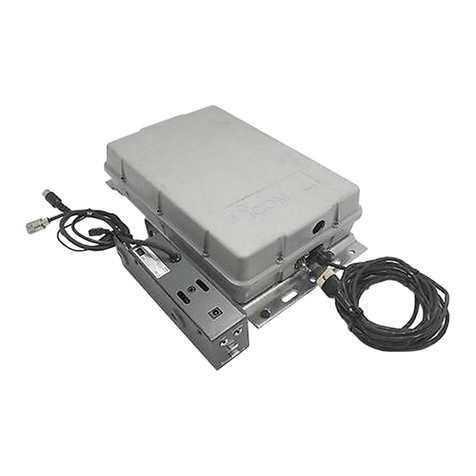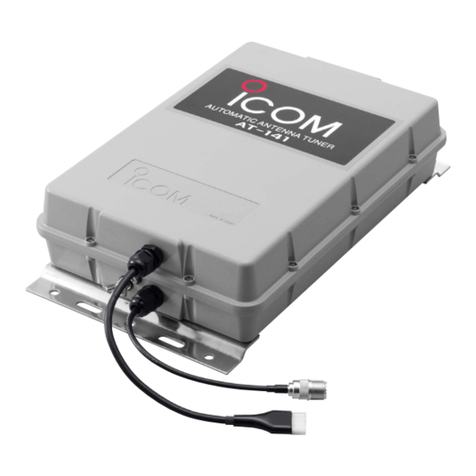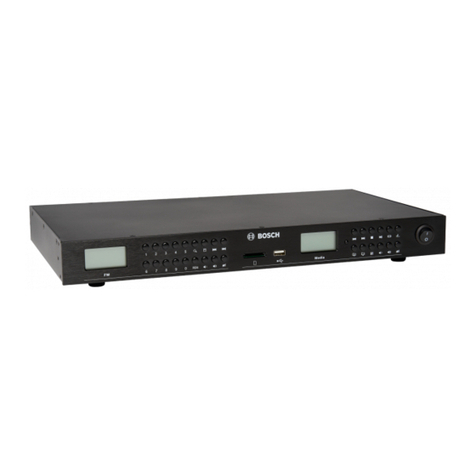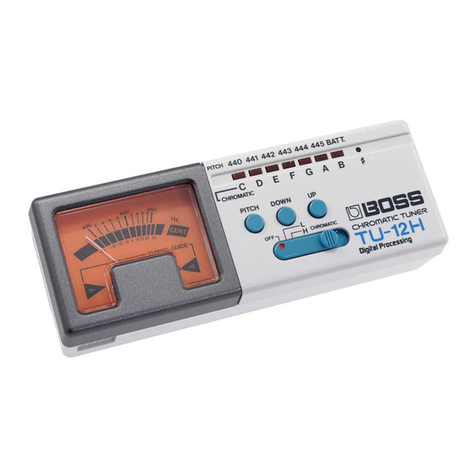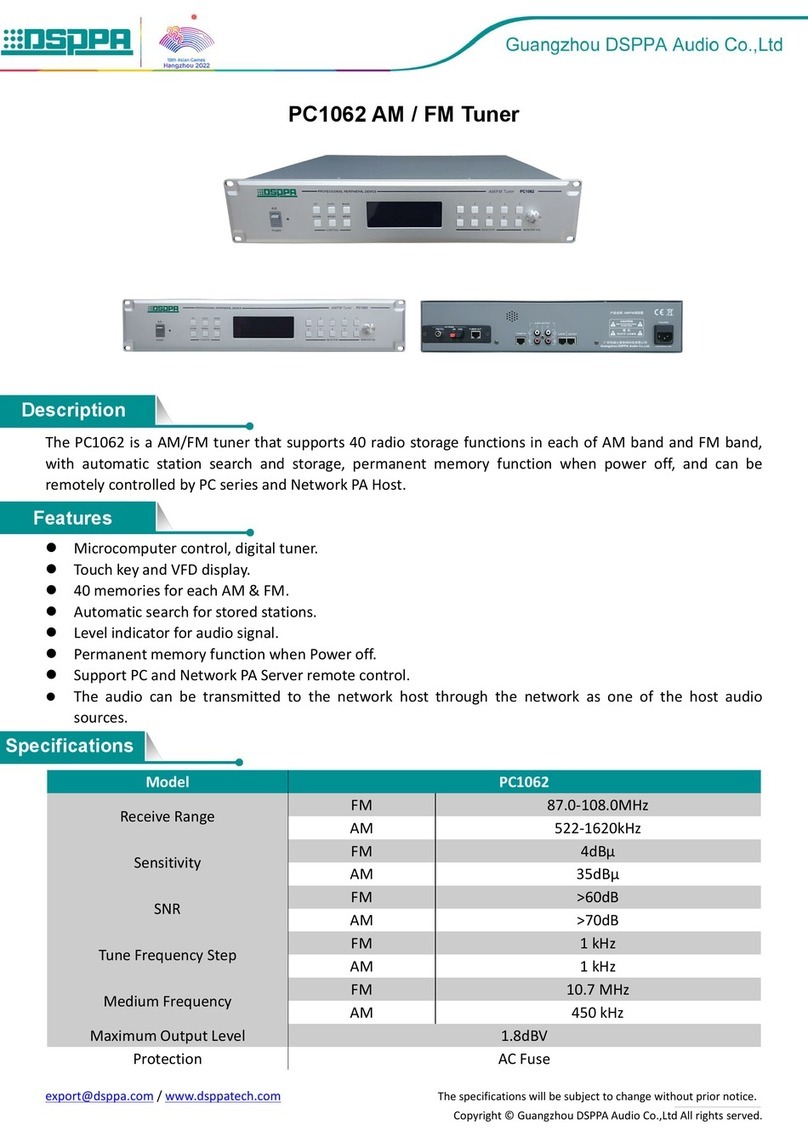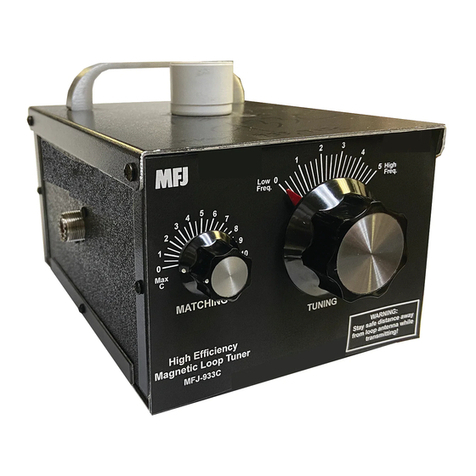axing RFQ-845 User manual

RFQ-845 | RFQ-845CI
RFO-845 | RFO-845CI
8PSK/QPSK/Multituner | DVB-T Quattro/Octo odules
Operation instructions

Operation instructions | Serie RFQ-845 and Serie RFO-845
Table of contents
1. Product description................................................................................................................................5
1.1. General...........................................................................................................................................5
1.1.1. Modules for D B-S/S2..........................................................................................................5
1.1.2. Modules with multituner for D B-S/S2, D B-T/T2 oder D B-C.......................................5
1.2. Scope of delivery...........................................................................................................................5
1.3. Inputs/tuners...................................................................................................................................6
1.4. Output/modulators.........................................................................................................................7
1.5. Graphical user interface.................................................................................................................7
1.6. Display elements and connectors...................................................................................................8
1.6.1. RFQ-845................................................................................................................................8
1.6.2. RFO-845................................................................................................................................9
2. Mounting and Installation....................................................................................................................10
2.1. Mounting and installation in a headend base unit........................................................................10
2.1.1. Mounting..............................................................................................................................10
2.1.2. Power supply........................................................................................................................10
2.1.3. Power supply in the headend base unit................................................................................12
2.2. External operation........................................................................................................................12
2.2.1. Power supply by external operation.....................................................................................13
2.3. Connection to D B-S..................................................................................................................13
2.3.1. Connection to the LNBs.......................................................................................................13
2.3.2. Multiswitches as input distributors......................................................................................13
2.4. Connection to D B-T/T2 or D B-C...........................................................................................13
3. Configuration.......................................................................................................................................14
3.1. Login and logout..........................................................................................................................15
3.2. Front page....................................................................................................................................16
3.2.1. Bit error rate.........................................................................................................................16
3.2.2. Fill level...............................................................................................................................16
3.2.3. CI menus..............................................................................................................................16
3.2.4. Initialization.........................................................................................................................17
3.3. Initialization phase 1....................................................................................................................17
3.3.1. D B-S (für 8PSK/QPSK- und für Multituner-Kassetten)...................................................17
3.3.2. D B-C, D B-T or D B-T2 (for multi tuner modules)......................................................18
3.3.3. Bit error rate.........................................................................................................................19
3.3.4. Found programmes..............................................................................................................19
3.4. Initialization phase 2....................................................................................................................19
3.4.1. Remux mode........................................................................................................................19
3.4.2. Scrambled programmes........................................................................................................20
3.4.3. Cross Multiplex Mode.........................................................................................................20
3.4.4. LCN (Logical Channel Numbering)....................................................................................22
3.5. Initialization phase 3....................................................................................................................22
3.5.1. Configuration of the modulator............................................................................................23
3.5.2. Fill level...............................................................................................................................24
3.5.3. Chosen programmes.............................................................................................................25
3.6. Maintenance.................................................................................................................................26
3.6.1. Updating firmware/software................................................................................................26
3.6.2. Changing the IP address.......................................................................................................26
3.6.3. Changing the password........................................................................................................27
3.6.4. Rebooting.............................................................................................................................27
3.6.5. Erasing service data.............................................................................................................27
22016-10-31 | Technical changes, design modifications, errors and misprints are subject to change without prior notice.

3.6.6. Save Initialization Data........................................................................................................28
3.6.7. Upload Initialization Data....................................................................................................28
3.6.8. Device name.........................................................................................................................29
4. Use of CA modules..............................................................................................................................30
4.1. Insertion of CA modules..............................................................................................................30
4.2. CI menu for RFQ-845CI and RFO-845CI...................................................................................31
4.2.1. Using CI menu.....................................................................................................................31
4.3. Decryption of programmes..........................................................................................................32
5. Technical data......................................................................................................................................33
5.1. Input multituner............................................................................................................................33
5.2. Input D B-S/S2 tuner..................................................................................................................33
5.3. Output/General.............................................................................................................................34
2016-10-31 | Technical changes, design modifications, errors and misprints are subject to change without prior notice.3

Operation instructions | Serie RFQ-845 and Serie RFO-845
Safety instructions:
The installation of the device and repair work on the device must be carried out only by a professional
in accordance with the applicable DE directives. In case of incorrect installation, no liability is
assumed.
Never open the device. There are no parts to be maintained by the user inside the device, however,
lethal voltages are present. This also applies to cleaning the device or working on the connections.
Use only the mains cable connected to the device or the enclosed power supply unit. Never replace any
parts or make any modifications to the mains cable and the power supply unit. Otherwise, there is a risk
of death.
If a replaceable fuse is available, pull out the mains plug before replacing the fuse. Replace defective
fuses only by standardized fuses with the same nominal value.
If you intend not to use the device for a longer period of time, we recommend you to completely
disconnect the device from the mains for safety reasons and for saving energy by pulling out the mains
plug.
Let the device adjust to the room temperature before commissioning, in particular if condensation is
present on the device, or if it was exposed to large temperature fluctuations.
The device must be operated only in moderate climate.
The device must be operated only in dry rooms. In damp rooms or outdoors, there is a risk of short-
circuits (attention: risk of fire) or electrical shocks (attention: risk of death).
Plan the mounting or installation location such that you can easily reach the mains plug and interrupt
the electric circuit in dangerous situations. Select the mounting or installation location such that
children cannot play near the device and its connections without supervision. The mounting or
installation location must allow a safe installation of all connected cables. Power supply cables and
supply cables must not be damaged or squeezed by any objects.
Select a mounting or installation location which meets the requirements of the IP 54 protection class.
Operate the device only on a flat, firm surface and protect it against unintentional movements.
Never expose the device to direct solar irradiation and avoid direct vicinity of heat sources (e.g. heaters,
other electrical appliances, fireplace, etc.). It must be always ensured that devices with cooling elements
or ventilation slots are not covered or obstructed. In addition, ensure generous air circulation around the
device. This will prevent possible damage to device and risk of fire due to overheating. It must be
always ensured that cables are not located near heat sources (e.g. heaters, other electrical appliances,
fireplace, etc.).
The device is intended for transmission of audio and video signals via LAN cable. Misuse of the device
is expressly prohibited.
In particular, the warranty and liability shall be excluded for the consequences of incorrect use, in case
of incorrect modifications or repair work carried out by the customer. Use the device only as described
in the operating instructions and in particular according to the state-of-the-art.
The antenna system must be installed and grounded according to the current DIN EN 60728-11
standard.
The product complies with the directives and standards for CE labeling.
42016-10-31 | Technical changes, design modifications, errors and misprints are subject to change without prior notice.

1. Product description
1.1. General
1.1.1. Modules with ultituner for DVB-S/S2, DVB-T/T2 oder DVB-C
RF type | Axing type
RFQ-845 | SKT 40-00M Transmodulates D B-S/S2, D B-T/T2 or D B-C into COFDM.
Four full-fledged tuner inputs, four modulators, one output.
RFQ-845CI | SKT 40-04M Like RFQ-845, decoding of encoded programs possible by using four CA
modules
RFO-845 | SKT 80-00M Transmodulates D B-S/S2, D B-T/T2 or D B-C into COFDM.
The RFQ-845 ist built in two units, each with four full-fledged tuner inputs,
four modulators and one output.
RFO-845CI | SKT 80-02M Like RFO-845, decoding of encoded programs possible by using two CA
modules.
1.2. Scope of delivery
1 × Headend module
1 × DC connection cable
1 × Quick start guide
Note. The power supply unit and the basic unit are not included in the scope of delivery of
the modules. They are available as an option. It is recommended to install the modules into a base unit.
2016-10-31 | Technical changes, design modifications, errors and misprints are subject to change without prior notice.5

Operation instructions | Serie RFQ-845 and Serie RFO-845
1.3. Inputs/tuners
The quattro module includes four independent tuners and the octo module includes eight of them.
Headend modules with 8PSK/QPSK tuners can receive D B-S/S2.
Headend modules with multituner can receive D B-S/S2, D B-T/T2 or D B-C. For receiving DVB-T/T2 or
DVB-C the LNB power supply has to been switched off (see 3.3 on page 17) before connecting a antenna
cabel to one of the HF inputs!
Connection to the LNBs
On the SAT-IF input the headend modules have a remote supply voltage for the LNB and use DiSEqC 1.0
functionalities. Therefore, they can be connected directly to the LNB.
Multiswitches as input distributors
Optionally, you can also use multiswitches as input distributors. The advantage of this solution is that you can set
both the SAT IF level and the satellite via the user interface. Changes in the list of programmes can be made
using remote maintenance, so that it is not necessary to change or modify the input distribution on site.
De odulation
The selection of the transponder and the demodulation of the QPSK/8PSK modulated signal are both made in the
tuner.
If needed, the programmes from the data flow of the demodulated transponder can be filtered (Remux mode).
Thanks to the Cross Multiplex Mode, FTA programmes (Free to Air) can be filtered from the data flow of several
tuners for a common output channel and be bundled again. The prepared data flow is passed on to the
modulators.
62016-10-31 | Technical changes, design modifications, errors and misprints are subject to change without prior notice.

1.4. Output/ odulators
The output channels of the odulators are allways neighbour channels
The quattro odule has four output modulators and one RF output.
The first modulator can be set to any output channel between S2 and CH 69. The other three modulators are
automatically set by incrementing the output channels in accordance with the chosen channel spacing.
For example: modulator 1 = Channel 21
modulators 2, 3 and 4 = Channels 22, 23 and 24
The octo odule has eight output modulators. They are subdivided in two modulator groups of four modulators
each. The octo odule has two RF outputs (each for one modulator group).
In both groups, the first modulator can be set to any output channel between S2 and CH 69. The next three
modulators of both modulator groups are automatically set by incrementing the output channels in accordance
with the chosen channel spacing.
For example: group A modulator 1 = Channel 21
modulators 2, 3 und 4 = Channels 22, 23 und 24.
group B modulator 1 = Channel 25
modulators 2, 3 und 4 = Channels 26, 27 und 28.
1.5. Graphical user interface
The settings of the modules can be changed via the user interface of the integrated web interface. To access the
user interface and thus configure the devices, you need a standard PC/laptop with a network interface and the
actual version of the installed web browser.
2016-10-31 | Technical changes, design modifications, errors and misprints are subject to change without prior notice.7

Operation instructions | Serie RFQ-845 and Serie RFO-845
1.6. Display ele ents and connectors
1.6.1.RFQ-845 | SKT 40-00M and RFQ-845CI | SKT 40-04M
1. 4 × MPEG data stream modulator LED indicators (each with two LEDs)
Error (red) = Modulator stream too large (fill level >95%, see 3.2.2 on page 16)
OK (green) = Fill level O.K.
2. 4 × HF input
3. RJ-45 Ethernet port
4. 4 × HF input LED indicator:
Orange = MPEG data stream present,
Off = MPEG data stream not present
5. Grounding screw
6. 1 x HF output
7. Fan
8. 2 × DC input/output
9. 4 x CI slots
82016-10-31 | Technical changes, design modifications, errors and misprints are subject to change without prior notice.

1.6.2.RFO-845 | RFO-845CI | SKT 80-0x | SKT 80-0xM
1. 8 × MPEG data stream modulator LED indicators (each with two LEDs)
Error (red) = Modulator stream too large (fill level >95%, see 3.2.2 on page 16)
OK (green) = Fill level O.K.
10. 8 × RF input
11. 2 × RJ-45 Ethernet port
12. 8 × RF input LED indicator:
Orange = MPEG data stream present,
Off = MPEG data stream not present
13. Grounding screw
14. 2 × RF output
15. Fan
16. 2 × DC input/output
17. 2 x CI slots
2016-10-31 | Technical changes, design modifications, errors and misprints are subject to change without prior notice.9

Operation instructions | Serie RFQ-845 and Serie RFO-845
2. Mounting and Installation
Notes
Before inserting or changing a module, pull the mains plug of the headend base unit from the socket!
Observe the operator's manual of the corresponding headend base unit!
Observe the operator's manual for the corresponding power supply unit!
The antenna system must be installed and grounded according to the DIN EN 60728-11 standard.
The headend modules can be operated either in a headend base units or stand-alone with the external power
supply unit.
The SAT IF inputs can be connected directly to a quattro LNB or to a SAT IF distributor. The plugged cable of
the headend supplies the LNB with power.
The input distribution can also be done via a multiswitch with up to 16 SAT IF levels.
2.1. Mounting and installation in a headend base unit
Install the base plate of the base unit in compliance with the safety regulations defined by the EN 60728-11
standard. Connect the base plate of the base unit with an equipotential bonding cable (copper, minimum 4
mm²).
2.1.1. Mounting
Every slot in the base unit has a fixing screw in order to install the headend modules.
Before the installation, the upper screw must be loosened.
When being attached to the output combiner, the module is at the same time mounted on the loosened screw.
Please tighten then the screw well.
2.1.2. Power supply
Please pay attention to the axi u nu ber of odules which can be supplied by the power supply unit
(see section 2.1.3 on page 12).
The modules have two identical connecting sockets on the bottom for the power supply.
Both are linked together internally. One of both connecting sockets is used to get the
operating voltage from the power supply unit or from another module. The second one can
be used to loop the operating voltage through to the next module or to the output combiner
of the base unit. With the DC patch cable (SKZ 40-00) included in the scope of delivery, the modules
can be connected together.
While looping the odules through, a axi u of 3 x RFO-845(CI) or 4 x RFQ-845(CI) can be
connected together.
Installation in the headend base unit RFT-804:
The power supply unit RFP-806, integrated in the headend base unit RFB-804, has a DC connecting cable on the
output side.
This cable is connected to the first module.
The other modules are connected to each other using the enclosed DC connecting cable SKZ 40-00.
A separate DC connecting cable SKZ 40-01 is additionally required to supply the output combiner. The
connecting cable SKZ 40-01 is included in the scope of delivery.
Connect the output combiner to the last module.
102016-10-31 | Technical changes, design modifications, errors and misprints are subject to change without prior notice.

Installation in the headend base unit RFT-808:
The power supply unit RFP-808 integrated in the headend base unit RFB-808 has a short and a long DC
connecting cable on the output side.
Connect the short DC connecting cable to the first module
Connect the long DC connecting cable to the fourth module.
The other modules are connected to each other using the enclosed DC connecting cable SKZ 40-00.
Two separate DC connecting cables SKZ 40-01 are additionally required to supply the output combiner. The
connecting cables SKZ 40-01 are included in the scope of delivery.
Connect the output combiner with one SKZ 40-01 to the last module on the right and with the other SKZ 40-
01 to the third module on the left side.
Installation in the base unit RFB-804:
The power supply unit RFP-806 is not included in the scope of delivery of the base unit.
Mount the power supply unit according to the enclosed operating instructions of the power supply unit.
The power supply unit has a short and a long DC connecting cable on the output side.
Connect the short DC connecting cable to the first module.
Connect the long DC connecting cable to the third module.
The other modules are connected to each other using the enclosed DC connecting cable SKZ 40-00.
A separate DC connecting cable SKZ 40-01 is additionally required to supply the output combiner. The
connecting cable SKZ 40-01 is included in the scope of delivery.
Connect the output combiner to the last module.
2016-10-31 | Technical changes, design modifications, errors and misprints are subject to change without prior notice.11

Operation instructions | Serie RFQ-845 and Serie RFO-845
2.1.3. Power supply in the headend base unit
The power supply units supply the modules with 16 DC voltage. The current consumption of all connected
modules must not exceed the maximal delivery of the power supply unit used.
The remote power rails at the SAT IF inputs must be added to the current consumption of the modules. The
current consumption at the SAT IF inputs is limited to 250 mA per input. Please take account of the current
consumption of the devices when choosing the LNBs or the multiswitches.
RFT-804 /
RFP-806 (10 A)
RFB-804* /
RFP-806 (10 A)
RFB-804* /
RFP-820 (2×10
A)
RFT-808 /
RFP-808 (18 A)
RFQ-845(CI)
1.5 A + LNB current
consumption
4 4 4 8
RFO-845(CI)
3A + LNB current
consumption
3 3 4 5
*Please note: The RFB-804 is supplied without power supply unit and remote control unit.
2.2. External operation
Please note that the installation must be carried out on an even and vertical surface.
Any unevenness must be compensated.
Fix the module with 2 screws appropriated for the installation surface.
Install the module in compliance with the safety regulations defined by the EN 60728-11 standard.
Connect the module with an equipotential bonding cable (copper, minimum 4 mm²).
For an operation without a basic unit, the outputs of several modules must be combined with a distributor.
122016-10-31 | Technical changes, design modifications, errors and misprints are subject to change without prior notice.

2.2.1. Power supply by external operation
When being operated externally, the module is directly connected to the DC power cable of the separate
power supply unit (e.g. RFP-803).
Every module has a DC loop output to supply another module with power. A SKZ 40-00 DC connection cable
is included in the scope of delivery of each RFQ/O-845 module.
Because of the current carrying capacity, the power supply units can only supply a certain number of modules.
The power supply units supply the modules with 16 DC voltage. The current consumption of all connected
modules must not exceed the maximal delivery of the power supply unit used.
The remote power rails at the SAT IF inputs must be added to the current consumption of the modules. The
current consumption at the SAT IF inputs is limited to 250 mA per input. Please take account of the current
consumption of the devices when choosing the LNBs or the multiswitches.
Please pay attention to the maximum number of modules which can be supplied by the power supply unit:
RFP-803 (4.5 A) RFP-806 (10A)
RFT-845(CI)
1.5 A + LNB 2 4
RFO-845(CI)
3 A + LNB 1 3
2.3. Connection to DVB-S
2.3.1. Connection to the LNBs
On the SAT-IF input the headend modules have a remote supply voltage for the LNB and use DiSEqC 1.0
functionalities. Therefore, they can be connected directly to the LNB.
2.3.2. Multiswitches as input distributors
Optionally, you can also use multiswitches as input distributors. The advantage of this solution is that you can set
both the SAT IF level and the satellite via the user interface. Changes in the list of programmmes can be made
using remote maintenance, so that it is not necessary to change or modify the input distribution on site.
2.4. Connection to DVB-T/T2 or DVB-C
Before connecting the antenna cabel, the LNB power supply has to been switched off (see 3.3 on page 17).
Active D B-T antennas have to be supplied by an external power supply.
The input level have to be 45-85 dBµ .
2016-10-31 | Technical changes, design modifications, errors and misprints are subject to change without prior notice.13

Operation instructions | Serie RFQ-845 and Serie RFO-845
3. Configuration
The device is configured via the graphical user interface of the integrated web interface.
To access the user interface, you need a standard PC/laptop with a network interface and the actual version of the
installed web browser. To connect the network interface of the module to the computer, you need a commercially
available network cable.
The HTTP protocol is used for communication allowing a worldwide remote maintenance of the systems at
various locations via the Internet. Access protection is implemented by means of the password prompt.
The RFO-845 features two separate units that each have four tuners, four modulators and one HF output. Every
unit has its own web interface and its own static IP address. The following values are preset ex factory:
RFQ-845(CI): IP address: 192.168.0.145
RFO-845(CI): IP address, left side: 192.168.0.145
IP address, right side: 192.168.0.146
Subnet mask: 255.255.255.0.
The computer and the module must be in the same subnetwork. The network part of the IP address of the
computer must be set to 192.168.0. and the subnet mask must be set to 255.255.255.0.
The host part of the network address is required for the identification of the devices and can be assigned in the
subnetwork only once. You can allocate to the computer any not allocated host address between 0 and 255.
Change the IP address and the subnet mask of your computer accordingly.
(e.g.: IP address:192.168.0.11 and subnet mask: 255.255.255.0)
Control panel > Network connections > LAN connection >Properties > Internet protocol version 4 TCP/IPv4 >
Properties > Use the following IP address:
Click OK to save.
Start your web browser and enter the IP address of the module: e.g.: 192.168.0.145.
3.1. Login and logout
The web-based user interface is protected against unauthorized access. When accessing the user interface, the
first thing is the password request.
142016-10-31 | Technical changes, design modifications, errors and misprints are subject to change without prior notice.

Enter the default password: amsen8262
Click the button ENTER PASSWORD .
If you are not automatically forwarded to the start
page, click then the button OPEN PAGE .
In the header, the user can choose the language of the user interface. The possibilities are German (DE) and
English (EN). The standard language of the user interface is English. The chosen language applies until the end
of the session.
To log out, click the button LOG OUT in the header of the website. In the browser, the message "Goodbye!“
appears.
Notes:
If the browser is closed while you are still logged in, an automatic logout occurs 2.5 minutes later.
If the browser window stays open, there is no automatic logout. It allows monitoring the installation via the
web browser.
Changing the password:
Please change the password immediately after the first commissioning and choose a sufficiently safe
password. Keep this password at a safe place.
Menu item: Maintenance > Set new password (see 3.6 on page 26)
Changing the IP address:
If needed, the modules can be integrated in a network. For this application, some changes must be applied to the
network configuration.
Menu item Maintenance > System Options (see 3.6 on page 26)
2016-10-31 | Technical changes, design modifications, errors and misprints are subject to change without prior notice.15

Operation instructions | Serie RFQ-845 and Serie RFO-845
3.2. Front page
The relevant information required for the function of the system are shown on the front page. The decisive thing
is the quality of the input signals and the utilization of the modulators.
3.2.1. Bit error rate
The bit error rate of all four SAT IF tuners is shown on the left side. The amount of bit errors for the last
1,000,000 transferred bits is calculated.
3.2.2. Fill level
The fill level of all four modulators is shown on the right side. 100% modulator fill level correspond to the
maximal net data rate of the output channel.
If the current fill level exceeds the maximal fill level, it may cause image disturbances, e.g. mosaic images.
The data rates of the programmes are not constant. They are dynamically changed by the sender. To ensure an
undisturbed reception, a reserve must absolutely be observed.
We reco end you to set the axi al fill level to 90%.
The number of choosen programmes (see 3.4 on page 19) and the configuration of the modulators (see 3.5 on
page 22) have an influence to the fill level.
3.2.3. CI enus
If CA moduls are used in RFQ-845CI or RFO-845CI, the CI menu buttons on the front page are active (see 4.2
on page 31).
162016-10-31 | Technical changes, design modifications, errors and misprints are subject to change without prior notice.
Here you can
navigate to the
Initialization
and
Maintenance
pages.

3.2.4. Initialization
The initialization is subdivided in 3 configuration phases.
Phase 1: Tuners.
LNB settings, DiSEqC settings,
Transponder frequency and transponder search run.
Phase 2: Chosse of progra es, progra e arrange ent.
Multiplexing after programme filtering (Remux mode)
Transponder crossing multiplexing of FTA programmes (Cross-Multiplex mode)
LCN (Logical Channel Numbering)
Phase 3: Modulators.
Channel spacing, output channel, fine calibration and output level.
Modulation, code rate, guard interval, transmission mode.
3.3. Initialization phase 1
During the first phase of the initialization, the tuner settings required for the scan are made and the station
scanning is carried out. The four tuners work independently from each other and after the same principle.
3.3.1. DVB-S
Choose the tuner with the button Tuner 1…4 .
Configure the needed settings for all tuners.
The SAT IF frequency of the transponder
is entered in the input field "Frequency
(MHz)".
The input fields "LOF Low Band (MHz)"
and "LOF High Band (MHz)" correspond
to the oscillator frequencies of the LNB in
low and high band.
The default settings of the oscillator
frequencies are 9,750 MHz for the low
band and 10,600 MHz for the high band.
In the optional field "Polarisation", you
can switch from horizontal to vertical.
In the optional field "DiSEqC", the
DiSEqC command signals can be turned
off or set to switch a DiSEqC-enabled
multi switch on the positions 1 to 4.
If required, the operating voltage for the
LNB can be switched off via the optional
field "LNB power supply".
After all settings have been made, click the button SCAN .
A rotating circle is shown on the right side during the scanning process.
2016-10-31 | Technical changes, design modifications, errors and misprints are subject to change without prior notice.17

Operation instructions | Serie RFQ-845 and Serie RFO-845
3.3.2. DVB-C, DVB-T or DVB-T2 (for ulti tuner odules)
Select any tuner by the help of the buttons Tuner 1…4 .
Before connecting an antenna cable to an according tuner, the LNB Power has to be set to off
Enter the center frequency (see table below) for the receiving channel into the field FREQ (MHz).
Note: All other entry
fields are not relevant.
Modulation and all other
important parameter for
reception are detected
automatically.
Channel Input Channel Input Channel Input Channel Input
S 21 306 21 474 41 634 61 794
S 22 314 22 482 42 642 62 802
S 23 322 23 490 43 650 63 810
S 24 330 24 498 44 658 64 818
S 25 338 25 506 45 666 65 826
S 26 346 26 514 46 674 66 834
S 27 354 27 522 47 682 67 842
S 28 362 28 530 48 690 68 850
S 29 370 29 538 49 698 69 858
S 30 378 30 546 50 706
S 31 386 31 554 51 714
S 32 394 32 562 52 722
S 33 402 33 570 53 730
S 34 410 34 578 54 738
S 35 418 35 586 55 746
S 36 426 36 594 56 754
S 37 434 37 602 57 762
S 38 442 38 610 58 770
S 39 450 39 618 59 778
S 40 458 40 626 60 786
S 41 466
Note: The center frequeny of channels using a bandwith of 7MHz will be rounded down to 3 full digits.
For example: center frequency of CH 5 = 177,5 MHz, the according input = 177.
3.3.3. Bit error rate
The BIT ERROR RATE is shown in the middle area. The amount of bit errors for the last 1,000,000 transferred
bits is calculated.
182016-10-31 | Technical changes, design modifications, errors and misprints are subject to change without prior notice.
Enter 3- digits for
center frequency Choose “Off”

3.3.4. Found progra es
After a successful station scanning, the radio and T stations are shown in the area "FOUND PROGRAMS".
The table contains information about programme type and encoding.
3.4. Initialization phase 2
In the initialization phase 2, the found programmes are subdivided by tuner. The programme name, the
programme type and information about the encryption are shown.
After the station scanning in initialization phase 1 no assignment to a output modulator has been done. The
output channels of the modulators still have no programme.
All lines of the programme table have in the "Modulator" column four colored buttons M1 to M4. The buttons
correspond to the four modulators. The allocation of the buttons is given in the COLOR CODES legend.
You can assign programmes to modulators in re ux ode or in cross ultiplex ode.
I portant:
With each programme you asign to an modulator, the data rate rises.
The performed modifications are only taken over by the system when you click the button SA E CHANGES .
3.4.1. Re ux ode
If the transport stream IDs of the four modulators and the network ID are set on "auto", the module works in the
Remux mode. In this mode, the IDs from the set transponder and from the satellite are used and forwarded to the
modulators with virtually no changes.
Assigning progra es
Every tuner is assigned to a modulator. The programmes of the tuner can only be assigned to the associated
modulator.
Click onto the modulator button, the programme is assigned to the modulator.
For example click in table TUNER 1 on the button M1.
The programme is assigned to modulator 1. The button of the modulator is highlighted in color.
Chose the programmes for TUNER 1 to TUNER 4.
2016-10-31 | Technical changes, design modifications, errors and misprints are subject to change without prior notice.19
Choosen
progra s for
odulator 1

Operation instructions | Serie RFQ-845 and Serie RFO-845
A new click on a button allow the assignment to be canceled. The modulator buttons fades then again.
3.4.2. Scra bled progra es
Scrambled programmes are indicated by the abbreviation CA in the column Encryption. They can be forwarded
in encrypted form, or be decrypted in the RFQ-845CI or RFO-845CI module by means of an integrated CA
module (see 4. at page 30).
3.4.3. Cross Multiplex Mode
The cross multiplex mode is used:
To split the programmes of a transonder to several modulators.
To merge pogams of several transponders into one output channel.
Transmission capacities in the distribution networks can be optimized.
Change the network ID to a value greater than zero.
The IDs of the transport streams are automatically incremented by one to four, the cross multiplex mode is
activated.
202016-10-31 | Technical changes, design modifications, errors and misprints are subject to change without prior notice.
This manual suits for next models
3
Table of contents
Other axing Tuner manuals
